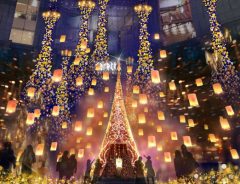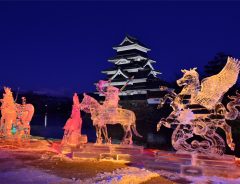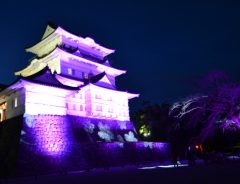- Tags:
- Exhibits / Illuminations / Plum / teamLab / Ume
Related Article
-

Tokyo’s Disney Princess Themed Illuminations Feature Frozen and Tangled This Christmas
-

The famous wisteria of Ashikaga Flower Park bloom early in time for spectacular festival
-

Coca-Cola Japan Celebrates The New Year With Plum Blossom And Kimono Design Bottle
-

Japan Noodle Trio Is Bringing Matcha And Other Japanese Flavors To Your Favorite Instant Noodles
-

Matsumoto Illuminations shine a winter limelight onto the Ice Carving Festival of 2022
-

See the Charming Odawara Castle by Taking an Easy Day Trip From Tokyo



Japan’s spring season is famous for the blooming of cherry blossoms throughout the country from around mid-march, but if you’re in Japan you would have noticed that the pink season actually starts around a month earlier, when the ume blossoms (or plum blossoms) start to bloom.
Ume blossoms are similar to cherry blossoms, but often come with much brighter hues. However, their similarity is strong enough to confuse even the most knowledgeable expert.
In Japan, almost every flower has it’s very own festival, and the ume blossom is no exception, with festivals celebrating it’s beauty throughout Japan.
Mito Plum Festival is one of the country’s most established plum blossom festivals. As the home to around 3,000 individual plum trees, it has been held at Mito’s Kairakuen for over 120 years.
This year the festival will be partnering up with popular art collective, teamLab, and will transform into an interactive art exhibit amongst the flowers.
Tickets are already on sale for the event, which is to be held at Kairakuen from 1 March – 31 March 2021. (The event was originally scheduled to be held from 13 February – 21 March 2021, but was postponed due to Ibaraki prefecture’s voluntary state of emergency.)
You’ve most likely heard of teamLab through their interactive exhibitions held at various locations across the globe. Arguably, their most popular exhibit is the permanent ‘teamLab Borderless’ at Odaiba in Tokyo.
Whilst the permanent exhibit at teamLab borderless focuses on the idea of free flowing digital art in a man made environment, the ‘teamLab Kairakuen Light Festival’, is part of teamLab’s ‘Digitalised Nature’ art project, where the focus is placed on artforms that already exist in the natural world.
The collaboration will see a handful of unique interactive illuminations, which will change depending on the presence of people within each exhibit, set up throughout the park. The aim is to represent the long history of the garden through the theme – ‘a long continuous life’.
生命は連続する光 - 梅林 / Life is a continuous light - Plum Trees
This part of the festival will see approximately 1,500 plum trees at Kairakuen light up and blink slowly in the night. As people pass by, the trees will shine and blink more intensely, before spreading out radially throughout the exhibit.
When light rushes from one area of the exhibit, it means that a person is present there. Life is a continuous light will make people more aware of the existence of other people in the same space.
自立しつつも呼応する生命と呼応する大杉森 / Autonomous Resonating Life and Resonating Giant Cedar Forest
This exhibit is dominated by illuminated cedar trees and interactive egg-shaped lights.
When the eggs are pushed by a person or blown by the wind, the hue of both the eggs and the closest trees will change in a rippling effect. A sound chosen to match the colour will also be released when the colour changes.
Just like the Life is a continuous light exhibit, people will be more aware of the presence of others in the same space when the lights change.
Walk, Walk, Walk - 孟宗竹林 / Walk, Walk, Walk - Moso Bamboo Forest
This display sees a continuous parade of unique and diverse figures walking along the Moso bamboo forest of Kairakuen.
Viewers can choose to stand in one spot and watch the progression, or they can follow their favourite characters and watch how they develop as time goes on.
The display is based around the zen expression ‘Hoho kore dojo’, which translates to ‘every step is a place to learn’. The characters of the display continue endlessly in the parade whilst confronting new situations. When viewers choose to either follow the characters along the parade or watch it progress pass, they too are making choices along their own pathway.
Walk, Walk, Walk is not a pre-recorded video played on repeat; instead, it is rendered in real time by a computer program. The interactions between people and the artwork causes a continuous change to the display, that cannot be replicated – this means that the artwork is in an ongoing state of change and that the images seen at any given moment will never be seen again.
増殖する生命の倒木 - 次郎杉 / Ever Blossoming Life Tree - Fallen Jiro Cedar
This art piece sees the continuous bloom and scatter of flowers inside of a rotten cavity of a large tree that fell during a typhoon in 1964. The flowers bud, bloom, scatter and eventually die, but the cycle is continuous, and replicates the fact that life continues on even after death.
The display is meant to get viewers thinking about how even though the time we have in existence is only finite, the continuity of life and death has been and will be on repeat forever. In everyday life, it is difficult to perceive this idea, as we don’t tend to focus on anything longer than our own lifetime – there seems to be a cognitive boundary when it comes down to thinking about the continuity of time.
増殖する生命の巨木 - 太郎杉 / Ever Blossoming Life Tree - Giant Taro Cedar
This exhibit is similar to the abovementioned Ever Blossoming Life Tree - Fallen Jiro Cedar, but this time the flowers bloom on a living tree that is believed to be more than 800 years old.
Kairakuen was designed in the late Edo period (1842), but giant trees like the fallen and living cedar trees have been at the site long before landscaping began. The Ever Blossoming Life Tree display highlights how various lifetimes and flows-of-time often intersect and overlap.
吐玉泉の円相 / Enso in the Natural Spring - Togyokusen
There have always been natural springs on the site of Kairakuen gardens, but when landscaping began, a well was built to collect the purest spring water from deep within the ground. This well is known as Togyokusen.
The drawing of a circle in one singular brush stroke is known as ‘enso’ in Zen teachings. It is believed to be a symbolic representation of enlightenment, truth, the entirety of the universe, and equality.
This artwork depicts an enso drawn with ‘spatial calligraphy’, meaning that it is drawn in a three dimensional space where it picks up the depth, speed and power of the brush stroke, before being flattened into two dimensions. In this way, the calligraphy shifts continuously between two and three dimensions.
具象と抽象 - 陽と陰の狭間 / Abstract and Concrete - Between Yin and Yang
This display is located on the border between the sun world or yin of the pine and azalea gardens, and the shadow world yang of the bamboo grass, cedar and bamboo forests.
When people stop walking inside of the artwork, a new set of lines are created and spreads across the area.
呼応する松とつつじ / Resonating Pine and Azalea
In this exhibit the pine trees and azalea bushes that grow in front of the Kobuntei tea house are lit up in a variety of colours. Each plant is lit up differently from the next, and continues through an ongoing state of shining brightly and fading.
When people stand near the trees, the hue of the lights change and a sound chosen to match the colour is released. The light and sounds are then transmitted to the nearby trees, one by one, as if part of a wave.
A brief introduction to Kairakuen
Kairakuen is a strolling garden which dates back to the late Edo period (1842). It is known as one of the "Three Great Gardens of Japan", along with Kenrokuen in Kanazawa and Korakuen in Okayama, and has been designated as a national historic site and scenic spot.
With around 3,000 different varieties of plum trees planted throughout the garden – each with their own blossoming schedule – Kairakuen is known throughout Japan as a famous place for plum blossom viewing.
You can find out more about the collaboration exhibition on the official teamLabs website. To read more about the Mito Plum Festival click here.
teamLab Kairakuen Hikari no Matsuri
Dates: 1 March – 31 March 2021
Time: 18:00 – 20:30 (Last Entry 20:00)
Venue: Kairakuen, 1-chome, Tokiwa-cho, Mito-shi, Ibaraki
Ticket Information
Sales period: 15 February – 31 March 2021
Adults: 1,500 yen
High School Students: 800 yen
Elementary School Students and younger: Free